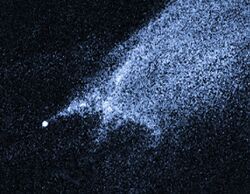Astronomy:2010 AA15
 2010 AA15 likely did not interact with main-belt comet P/2010 A2 | |
| Discovery[1] | |
|---|---|
| Discovered by | MLS |
| Discovery site | Mount Lemmon Obs. |
| Discovery date | 7 January 2010 (first observation only) |
| Designations | |
| 2010 AA15 | |
| Minor planet category | main-belt[1][2] |
| Orbital characteristics[2] | |
| Epoch 16 February 2017 (JD 2457800.5) | |
| Uncertainty parameter 6 | |
| Observation arc | (15 days) |
| |{{{apsis}}}|helion}} | 2.6329 AU |
| |{{{apsis}}}|helion}} | 1.9933 AU |
| 2.3131 AU | |
| Eccentricity | 0.1383 |
| Orbital period | 3.52 yr (1,285 days) |
| Mean anomaly | 6.7537° |
| Mean motion | 0° 16m 48.72s / day |
| Inclination | 4.6880° |
| Longitude of ascending node | 324.05° |
| 142.78° | |
| Physical characteristics | |
| Mean diameter | 380 m (est. at 0.24)[3] 840 m (est. at 0.05)[3] |
| Absolute magnitude (H) | 19.254±0.3468[2] |
2010 AA15 is a sub-kilometer asteroid from the inner asteroid belt, that has a similar but different orbit than main-belt comet P/2010 A2.[4] During January 2010, it had been observed for two weeks by the Mount Lemmon Survey, but has since become a lost asteroid. (As of 2020) the object has not been recovered.[1]
Description
Using the best-fit short-arc orbital data, it appears as if the closest that comet P/2010 A2 came to asteroid 2010 AA15 is around 0.0155 AU (2,300,000 kilometres (1,430,000 miles)) on 22 November 2009.[4]
This asteroid was discovered on 7 January 2010.[2] Since it has only been observed over a fifteen-day arc of its 3.5 year orbit, details of the exact orbit still need further refining for easy recovery of this object in the distant future.[2] The asteroid appears to have come to perihelion (closest approach to the Sun) on around 10 January 2010,[2] only a couple days after its discovery.
Based on an absolute magnitude of 19.2,[2] and an assumed albedo of 0.24 and 0.05, 2010 AA15 is likely to measure 380 meters (1,250 feet) and 840 meters (2,760 feet) in diameter for a stony and carbonaceous composition, respectively.[3]
See also
- Asteroid impact prediction
- List of asteroid close approaches to Earth
- List of Earth-crossing minor planets
References
- ↑ 1.0 1.1 1.2 "2010 AA15". Minor Planet Center. http://www.minorplanetcenter.net/db_search/show_object?object_id=2010+AA15. Retrieved 28 April 2017.
- ↑ 2.0 2.1 2.2 2.3 2.4 2.5 2.6 "JPL Small-Body Database Browser: (2010 AA15)". Jet Propulsion Laboratory. http://ssd.jpl.nasa.gov/sbdb.cgi?sstr=3485596. Retrieved 28 April 2017.
- ↑ 3.0 3.1 3.2 "Asteroid Size Estimator". CNEOS NASA/JPL. https://cneos.jpl.nasa.gov/tools/ast_size_est.html. Retrieved 9 September 2020.
- ↑ 4.0 4.1 Ireneusz Wlodarczyk (2010-02-03). "Re: {MPML} P/2010 A2, 2010 AA15 results of a collision? (probably no)". Yahoo! Groups (Minor Planet Mailing List). http://tech.groups.yahoo.com/group/mpml/message/23003. Retrieved 2010-02-03.
External links
- 2010 AA15 at the JPL Small-Body Database
 |

